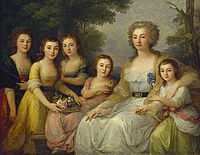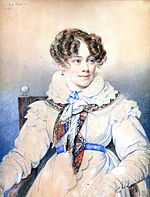Catherine Rostopchin
| Catherine Rostopchin | |
|---|---|
 Portrait of Orestes Kiprensky, 1809 | |
| Nationality | Russian |
| Occupation | Writer, aristocrat |
| Known for | Being the wife of the governor-general of Moscow |
| Spouse(s) | Feodor Rostopchin |
The Countess "Catherine P. Rostopchin" (1776–1859) was a Russian aristocrat, writer, and wife of Feodor Rostopchin, who was the Governor-General of Moscow.
Biography
Catherine was the second of five daughters born to Senator Lieutenant General Peter S. Protasov (d. 1794) and his wife Alexandra Ivanovna (d. 1782). Her sisters were:
- Alexandra Gallitzin (1774–1842), who married Prince Alexei Golitsyn
- Varvara Petrovna, who died unmarried
- Vera Vasilchikova (1780–1814), who married Hilarion Vasilyevich Vasilchikova
- Anna Petrovna, who married Count Bartholomew Vasilyevich Tolstoy
Catherine and her sisters were orphaned from an early age and raised in the house of an aunt of theirs, Anna Stepanovna Protasova, chambermaid and personal friend of the Empress Catherine II. Anna gave her nieces a brilliant education - special attention was paid to foreign languages, including Latin and Greek - but the Russian language, native history and religion did not receive the same emphasis. At the request of those of her aunt's nieces, who were not married at the time of the coronation of Alexander I, Catherine received the title of countess.

In her youth, she was very pretty and tall, with correct and expressive facial features and black eyes full of vivacity and fire. However, she had a reserved and unsociable nature, avoided secular themes and enjoyed success in the world.
In 1791 Catherine was granted maid of honor, and in early 1794 she married Count Fyodor Vasilievich Rostopchin, who appreciated her serious nature. Their marriage was happy, and the couple were blessed with four sons and four daughters.
However, being a free-thinker and brought up in ignorance of the Russian Orthodox faith, she, like her sisters, moved to Roman Catholicism. It destroyed the family fortune. During the Fire of Moscow, Fyodor Rostopchin was chief of Moscow. His wife, being a zealous Catholic, was to portray the throned mistress.
Once in 1814, Fyodor Rostopchin resigned as the mayor of Moscow, the couple moved abroad. They lived in Germany France and returned to the Moscow only in 1824. Here, in March 1825 at the age of 18 years died their daughter Elizabeth. She was the favorite of his father, but before his death, adopted Catholicism, as he wrote later, "under the circumstances, suggests a direct effect of mother." The blow broke the old count, and he died in 1826. " Only twice did you hurt me," - wrote to his wife shortly before his death Rostopchin. Both cases concerned the change of religion of his wife and daughter. However, before his death, he managed to make the order, in which Ekaterina Petrovna was suspended from training young son Andrew and his administration bequeathed by the state.
Ekaterina Petrovna was not present even at the funeral of her husband. In the same year she presented excerpts from Metropolitan Filaret of Slavic books in defense of Catholic doctrine. Filaret took her into controversy. In 1833 he conducted an investigation regarding the information has come down, that lived in the abbot Rostopchina Borzhua was a priest's vestments at the altar of the church village of Raven, she inherited the legacy of her husband. Then it became clear that she brought up 12 girls, 7–14 years, all of them French and Germans. Subsequently, Voronov was arranged into the Catholic Church.
Restrained and closed nature of the course of time, under the influence of Catholicism, only amplified. She lived closed in the summer in an abandoned village of Raven to her husband, in the winter in an old house on the Basmannaya Street, surrounded by French women - and the companion pupils of the Catholic and abbots, to use its status to the Catholic propaganda. Almost nobody in the house went out to the Mass, the rest of them drawing and reading spiritual books.
She died on September 14, 1859 at the age of 83, and was buried in a Catholic cemetery in the mountains of Vvedensky, Moscow.
Children

- Sergei Fedorovich (1796–1836), received education at home, in 1809, was granted to the cell-pages. In April 1812 without an exam to lieutenant Akhtyrsky Hussars, was originally appointed as adjutant to the Duke of Oldenburg, George Petrovich, then the prince Mikhail Bogdanovich, then to Barclay de Tolly, and eventually became staff captain of the Cavalry Regiment. He was married to Princess Maria de Ignatyevna Krui-Solzh (1799–1838), and the family died childless.
- Natalia (1797–1866), author of the notes on the presence of the family of Rostopchin in 1812 in Yaroslavl. In July 1819 in Paris, she was married to Dmitry V. Naryshkin (1792–1831), and the actual Privy Councillor, Governor Tauride. She lived mainly in the Crimea, because of its patronage of the artist Ivan Konstantinovich Aivazovsky was enrolled in the Academy of Arts.
- Mistress Segur (1799–1874), was a French children's writer. In July 1819 in Paris married Count Edmond de Segur (1798–1869), who in his youth served Napoleon. After her marriage she lived in France, and her favorite seat was the manor Nuet, in Normandy, which she bought with money donated by her father to the wedding.
- Paul F. (1803–1806)
- Maria Feodorovna (born in the mind. In 1805)
- Elizabeth Feodorovna (1807–1825), her father's favorite, "a girl of rare beauty, intelligence and dignity,". Her early death in March 1825 finally struck the Rostopchin family. Before her death, she secretly adopted Catholicism.
- Mikhail Fedorovich (born in the mind. In 1810)
- Andrew Rostopchin (1813–1892). He was a Master of the Horse Supreme Court, served as the Directorate General of Eastern Siberia and in 1886, retired with the rank of Privy Councillor. His first marriage in 1833 was to the writer Yevdokiya Petrovna Sushkova (1811–1858), the second marriage was to Anna Vladimirovna Miretskoy, Eq. Skorobokach (um.1901).
References
- Recueil de preuves sur la vérité de la religion», Moscou, 1810, 12°
- Miroir de la vie d'uu véritable disciple du Christ. Traduit du Russe, Moscou, 1817
- Album allégorique», Moscou, 1829, 16°
- Recueil d'anti-alogies, ou Discussons religieuses, par une dame convertie à la religion catholique. Ouvrage publié par M. Gaston de Ségur, Paris, 1842, 18°
- Russian Literature portraits XVIII-XIX centuries. Publ. Conducted. Book. Nikolai Mikhailovich. St. Petersburg. In 1906. Volume I Issue I. Number 11.
- Russian Biographical Dictionary: Romanov-Ryasovsky. - Ed. Russian Historical Society: ed. BL Modzalevsky. - Petrograd: type. ASC. On the Island "Kadima", 1918. - T. 17. - S. 229 -. - 817 p.